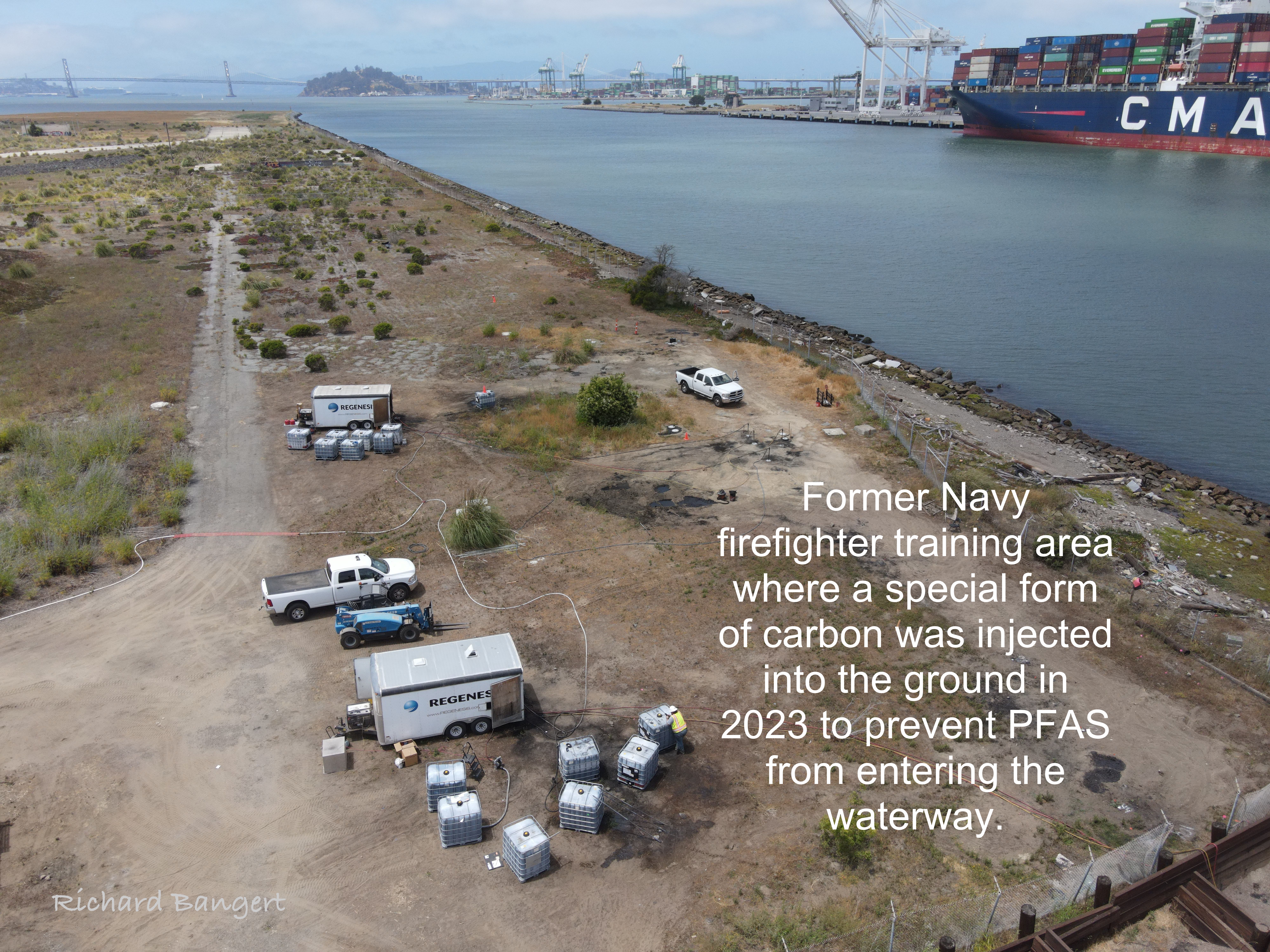On April 19, 2024, the U.S. Environmental Protection Agency (EPA) elevated the classification of PFAS chemicals from a “pollutant” to a “hazardous substance.” This should have come as good news to the City because the Navy will be forever responsible for any contamination problems that might arise later, making way for speeding up the city’s efforts to sell a valuable hangar at Alameda Point to gain revenue for replacing outdated and failing infrastructure. But, not so fast.
Transfer of Building 41 to City awaits Navy PFAS review
Because the former Naval Air Station, now known as Alameda Point, has been undergoing environmental cleanup under the jurisdiction of Superfund law, one of the rules requires that the Navy now complete a separate Record of Decision on PFAS before transferring Building 41, the hangar at the corner of West Tower Avenue and Ferry Point Road, to the City. Had PFAS been listed as a hazardous substance when the cleanup process started, the Navy would have dealt with it along the way by doing PFAS assessments, followed by remediation plans where PFAS is present.
But now with Records of Decision approved by the regulatory agencies and the Navy on all 34 cleanup sites, the Navy has no choice but to embark on a separate review process for PFAS. This means completing detailed investigations, health risk assessments, and feasibility studies for remediation of PFAS at the 11 sites identified in the Navy’s August 2023 PFAS report. It is not uncommon for such a process to take five years or more.
The main impetus for the new EPA ruling is “to protect people and communities from PFAS contamination in drinking water…,” states the EPA news release. The elevation of PFAS from “pollutant” to “hazardous substance” extends beyond just water supplies. It now means it is on the list of some 800 chemicals that must be remediated at Superfund sites, including at Alameda Point.
Department of Defense gets proactive on PFAS before EPA
The Department of Defense (DOD) began its own program of remediating PFAS contamination at current and former military bases back in 2019, years before the EPA’s current ruling. It is the reason the Navy recently undertook its pilot plan to see if a special form of carbon can prevent PFAS from migrating into the Oakland Estuary from the former firefighter training area. PFAS is the active ingredient in firefighting foam. If deemed successful, the PFAS-sequestering carbon system could be employed at other sites.
As good as the DOD policy is, however, it is only a policy and subject to change. In any event, this policy will not shield future property owners from liability. Only the Superfund law, also known as CERCLA (Comprehensive Environmental Response, Compensation, and Liability Act), can do that.
In order for a CERCLA site to be transferred to another owner, a Record of Decision must be completed in which the nature and extent of contamination, health impacts, and remediation efforts are memorialized. It is similar to a court settlement, in that it provides finality for all future owners that the original generator of the contamination will always be the responsible party. In other words, it shields the City as interim owner from future liability.
City avoids PFAS liability risk by not accepting building
In order to avoid being held liable for PFAS contamination, the City did not agree to accept ownership of Building 41, the hangar at 650 West Tower Avenue, in 2018 when the Navy deemed it suitable to transfer after other groundwater issues had been successfully treated. PFAS had been identified during Navy soil and groundwater testing as being present underneath the building. But without PFAS having been officially part of the CERCLA process, the City would have exposed itself to the risk of a lawsuit concerning PFAS. The Navy is only perpetually responsible for CERCLA chemicals.
Health science data are bad news for PFAS
The trajectory of science surrounding PFAS was pointing toward the eventual listing of PFAS as a hazardous substance by the EPA. Numerous household brand names have been pulled from the market in recent years due to health concerns over the presence of PFAS. Lowe’s and Home Depot announced in 2019 that they would no longer sell carpets and rugs containing PFAS, which was added for stain resistance.
But the trajectory of science was not a sound basis for the City to make a risk-based decision. There is still an outside chance that the PFAS ruling could be tied up in court for years. Alameda’s Director of Base Reuse and Economic Development, Abby Thorne-Lyman, pointed out the possibility saying, “We expect the PFAS CERCLA rule to take effect July 8, unless it is stalled by litigation at the federal level.”
PFAS risk at Building 41 is minimal
To become a health risk, PFAS must be ingested. There is virtually zero chance this can happen at this location due to the fact that the land is covered by a concrete slab and the outside is covered by pavement, according to the Navy’s August 2023 PFAS report. With regard to Building 41, the report said that “although construction workers may contact groundwater during intrusive soil activities such as trenching or subsurface utility work, dermal contact with groundwater is an incomplete exposure pathway because the absorption of PFAS from water through the skin is low.”
Nevertheless, the report concluded by saying that the analytical results showing the presence of PFAS mean that the site will be part of the larger PFAS Record of Decision process.

The Takeaway on Building 41 and PFAS
The EPA’s April 19 PFAS announcement would have been welcome news for the City, but for the fact that PFAS was never part of the CERCLA process at Alameda Point. Therefore, the Navy cannot legally transfer the hangar until it completes a separate CERCLA Record of Decision on PFAS.
“Our plan for Building 41 was always to engage in a long term lease with an option to purchase to address the uncertainty associated with PFAS,” said Thorne-Lyman.

Building 41’s only current tenant is DOER Marine, following the departure of the main tenant Wrightspeed. The City has been in negotiations with DOER Marine for a new license agreement in Building 41. “We are working with DOER to ensure the stability of their business in light of this news from the EPA, and will be bringing an update to the City Council this summer,” said Thorne-Lyman.
Originally published on the Alameda Post.


